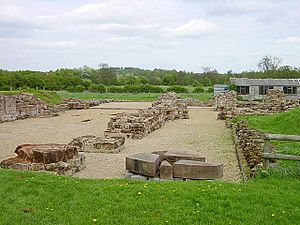Bordesley Abbey facts for kids
Bordesley Abbey was a large monastery built in the 12th century. It was home to Cistercian monks and was located near the town of Redditch in Worcestershire, England.
The abbey was started by Waleran de Beaumont, who was the Count of Meulan. He gave land to monks from Garendon Abbey in Leicestershire. However, Empress Matilda later claimed control over Bordesley. This happened after Waleran gave up his power to her around 1141. This made Bordesley a royal monastery.
Bordesley Abbey was once a very important religious place in the area. It even had political control over the old township of Tardebigge. But its importance ended when King Henry VIII closed down many monasteries. This was called the dissolution of the monasteries. Bordesley Abbey was pulled down in 1538, and its land was sold.
Today, the ruins are an archaeological site. Experts from the University of Reading have been studying it since 1969. This project is called the Bordesley Abbey Project. Many items found during these digs can be seen at a visitor centre and museum. This museum is connected to the Forge Mill Needle Museum. A famous person, Guy de Beauchamp, 10th Earl of Warwick, was buried at the Abbey.
What Was Bordesley Abbey Like?
The abbey is in Redditch, Worcestershire. It sits on the south bank of the River Arrow. This is near where it meets the Batchley Brook. Digs by the University of Reading show that the main part of the abbey was its church. The church was built on a hill. Its western side was partly dug into the slope.
Because of its location, the building could slip. So, strong supports called buttresses were added. More supports were put in during the 13th and 14th centuries. This happened after a big part of the building collapsed. The abbey was also the burial place for Guy de Beauchamp, 10th Earl of Warwick. His family had given a lot of money to the abbey over the years.
Today, you can see parts of the abbey's walls and earthworks. Other parts, like the watermill and workshops, are still buried. The site is looked after by the Forge Mill Needle Museum. You can visit the abbey ruins with your museum ticket. Guided tours are also available. Since 1957, Historic England has called the abbey a scheduled monument. This means it is a very important historical site.
The Abbey's History
Bordesley Abbey was started during a difficult time in England. This period was known as The Anarchy. It was a time of disorder after King Stephen came to power. Most historians believe the abbey was founded in 1138. This is when Waleran de Beaumont signed a special paper for the site.
However, another paper from Queen Maud says it was founded in 1136. Waleran himself witnessed this paper. After the Battle of Lincoln in 1141, Waleran changed sides. He stopped supporting Stephen and joined Maud. It is possible he gave up his claim to the abbey to Maud at that time.
Waleran set up the abbey for Cistercian monks. They had been living at Garendon Abbey in Leicestershire. The area chosen for the abbey was in the River Arrow valley. It was mostly marshland back then. The monks had to drain the land and move the river. This made the area suitable for building.
The first buildings were made of wood. Stone buildings were put up a few years later. The church was the first part of the abbey to be finished, around 1150. Other parts were built in five main stages until the early 14th century. The abbey gained a lot of land in the area. They used this land to farm crops like cereal and wool to sell.
They managed this farming through about twenty granges. These were like farm outposts. They were set up by the early 13th century. These granges were in Worcestershire and Warwickshire. Some were as far as 35 kilometres (22 mi) from the abbey. In the 13th century, a gatehouse and a chapel were built. This chapel was called the chapel of St Stephen. It was still used by the local people even after the abbey closed. It was pulled down in 1805 when a new church was built in Redditch.
The abbey closed on 17 July 1538. This happened during the dissolution of the monasteries under King Henry VIII. The last abbot, John Day, gave the land and everything else to the king. Henry then sold the land on 23 September 1538.
Burials
See also
 In Spanish: Abadía de Bordesley para niños
In Spanish: Abadía de Bordesley para niños


